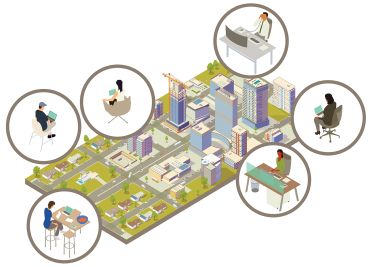Q&A: Skyline AI CEO Guy Zipori Discusses the Future of Tech and AI in CRE
By Mack Burke August 17, 2018 12:00 pm
reprints
It’s no secret that many industries have experienced disruption from technological innovation, from Uber’s effects on the taxi industry to delivery services on the retail sector.
Israeli startup Skyline A.I. utilizes commercial real estate data from 150 sources to detect and exploit market anomalies, identify superior risk-reward investments and discover untapped value-add opportunities, per its website.
Founded in Tel Aviv last year, Skyline A.I. was formed by four Israeli serial entrepreneurs in CEO Guy Zipori, CTO Or Hiltch, CRO Iri Amirav and the platform’s chairman, Amir Leitersdorf. It made the first-ever real estate transaction vetted by artificial intelligence in June, when it completed a $26 million transaction for two multifamily properties in Philadelphia, analyzing the deal without human involvement.
“That was an important milestone for us,” Zipori said. “We plan to do another six investments in the next 12 months and also enter into other asset classes.”
Since then, the group has partnered with Greystone Labs—the firm’s technology innovation department—to gain additional data points and boost its asset performance predictions. And in late July, it announced it raised $18 million in a Series A funding round, led by Sequoia Capital, in order to add other asset classes and capabilities to its platform.
Zipori chatted with Commercial Observer in early July to discuss what’s next for product and commercial real estate tech innovation.
Commercial Observer: Tell us about Skyline’s product and how the firm has fared in its first year?
Guy Zipori: We’re trying to get our hands on every piece of information that might affect real estate values—everything from crime and education and demographics to restaurants, treasury data and LIBOR and stock market data—and information about real estate itself, the properties, the debt, recent transactions and so on. Today, we have 150 different data sources. We started with multifamily assets, so we’re monitoring all the multifamily assets in the U.S that have more than 50 units. That’s about 400,000 different properties, and for each property we have about 10,000 different data points, going back in time 50 years depending on the data point and the property.
Walk us through how your system boosts the underwriting process and subsequent deal performance?
The way the product is designed is that you put in a [property] address and instantly receive a full underwriting report with all the information that you need to know about the asset, and all the insights and predictions that we could extract out of the data. You instantly get feedback on how much the asset is worth today and what will happen in the next few years. You can see if there is a value-add opportunity on the asset, what the income and the expenses are and what’s happening in the surrounding area. We’re building a business model for each asset automatically, so you’ll get a model with a full 15-year pro forma. You get all this information—what might take many people weeks to put together. And since we have so much information about so many assets in the U.S., this also helps with deal sourcing. You can query the system and ask specific questions based on your philosophy or the asset that you’re looking at and get a full list of assets that meet the criteria.
Why the initial focus on multifamily?
We started with multifamily with plans to venture into other asset classes. There are a few reasons for that. There’s a lot of data in multifamily, so it made more sense for us to start with this, although I think the impact and the results we’ll be able to show in other asset classes will be even more interesting because of the lack of data in some areas. We started with multifamily, one because of the data availability, but also because of our investors who have large appetites for it.
What drew you and your partners to the commercial real estate industry?
When we started to invest in real estate, first in Israel and then the U.S., with different asset classes, investors were amazed by how old the real estate industry is when it comes to technology. As smaller real estate investors, we saw the challenges of investing in commercial real estate and how people analyze real estate opportunities today. We thought that there was room for new technologies in this space. New technologies can make a change in commercial real estate investment. It’s the largest industry that exists today. AI and machine learning and big data is already everywhere, but we were amazed that it’s not yet prominent in the real estate business.
Recent surveys show that commercial real estate professionals don’t seem to expect significant tech change over the next five to 10 years. Is there any real risk of human displacement?
We’re not trying to replace people. It’s about empowering people, and when we started we were afraid about whether people who are doing very well in real estate investment would be positive about embracing the new technology. We were surprised when we met commercial real estate leaders; they are open and understand this will happen and will impact the way people invest in commercial real estate.
The CRE industry seems a bit slower to adapt to or embrace tech disruptions. Why do this now and why do you think more companies are likely to embrace the data and technology that’s available to them in this capacity?
People, when we started, would tell us they think we came in at a bad time because of the real estate cycle. And I think it’s the opposite because in the last 10 years, for you to make yield in real estate, it seems the main thing you should have done is buy real estate. Most of the investors understand and would agree that the next 10 years will probably look different, and in more difficult times, you need an advantage and that’s what we’re trying to create. What we can do today wasn’t possible several years ago. People see the impact that new technology has on other industries, so they understand the potential of leveraging similar technologies in real estate. Eventually you can’t compete with machines.
Can you talk about this partnership with Greystone Labs and what’s it’s done for Skyline? What’s possible now?
We’re trying to improve our predictions and insights all the time. Our predictions and insights can only be as good as our data. I mentioned we have 150 different data sources. We’re working very hard on getting good, quality data that will allow us to have better predictions and then produce better decisions based on the system. This is the main thing about the data in this partnership. They have a lot of experience. We’ve learned a lot from our conversations, and I think that it’s really a win-win for both sides.
What do you think are some of the hurdles associated with prop-tech right now?
Today you need to find big players who are open to embracing the technology we’re trying to bring to the market. The risks and benefits are controlled by large institutions and families. We need to make sure that if you develop, it’s something that people need—it’s not only in prop-tech, but in prop-tech it’s even harder because you need those influential people to understand the benefits of what you’re doing.


